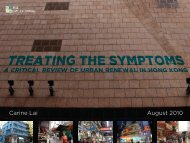Untitled - Civic Exchange
Untitled - Civic Exchange
Untitled - Civic Exchange
Create successful ePaper yourself
Turn your PDF publications into a flip-book with our unique Google optimized e-Paper software.
SUSTAINABLE TRANSPORT IN HONG KONG: DIRECTIONS AND OPPORTUNITIES<br />
Table 5.3<br />
Estimates of comparative noise levels for buses<br />
with diesel, CNG, fuel cell, or electric motors<br />
Vehicle type Power source Estimated noise level<br />
(in decibels)<br />
Bus Diesel engine 82<br />
CNG 75<br />
Fuel cell 68<br />
Trolley bus Electric 60<br />
City street background 60<br />
Source: Citybus Ltd., personal communication from John Blay, March 20, 2001<br />
A study cited by Wong rated diesel buses at 94 decibels and electric trolleybuses at 74 decibels, figures<br />
higher than those cited above. 136 Yet while these noise levels are higher, electric trolley buses are still about<br />
20 decibels quieter than diesel buses, a substantial advantage.<br />
• Policy approach<br />
Trams and electric trolley buses seem well suited to help reduce serious air and noise pollution in Hong<br />
Kong. Yet CTS3 is, at best, ambivalent about tethered electric vehicles as part of any attempt to make Hong<br />
Kong's transport system more sustainable.<br />
The few references to trams are limited to comments about the value of Hong Kong's existing trams (i.e.,<br />
their usefulness for short distances when speed is not a concern, but where low cost is an important<br />
advantage). CTS3 does not even mention the possibility of modern trams for Hong Kong, such as those in<br />
use in a number of European cities. One possible explanation is that Hong Kong's "antique" trams are quite<br />
narrow and do not take up the amount of road space required by modern, more comfortable trams.<br />
Reluctance to concede some additional road space appears to have superseded the obvious benefits of<br />
wider, faster, and more comfortable modern trams.<br />
Whatever the reasons for failing to mention modern trams in the CTS3 report, this was a serious omission.<br />
Modern trams could be an integral part of local transport in new town developments as well as in some<br />
older urban areas. The major limitations of trams are that they are restricted to flat or nearly flat areas and,<br />
being heavy, may require strengthening of roadbeds. However, trams are well suited to reclaimed areas,<br />
which tend to be flat, such as the northern shoreline of Hong Kong Island, the Kowloon peninsula, 137 and<br />
parts of the New Territories. 138 Trams can also be used imaginatively in conjunction with pedestrian<br />
schemes, such as those being proposed by the Hong Kong Institute of Planners. 139 CTS3 does note that<br />
Hong Kong's existing trams (which currently account for nearly 3% of all road journeys) should continue<br />
to play a role in short trips and in providing feeder service to heavy rail.<br />
Electric trolley buses do not suffer the same limitations as trams in terms of speed and restriction to flat<br />
44<br />
136 Wong Hong Chung (1999), Potential and Limitations for Trolley Bus Transport in Hong Kong.<br />
137 An ideal area would be the planned South East Kowloon reclamation.<br />
138 Introduction of modern tram service would be very suitable in the new Tseung Kwan O development, despite<br />
the fact that government planners failed to consider options for eliminating transport-related local pollution during<br />
site design.<br />
139 The Des Voeux Road Central Pedestrianisation Focussed Study: Final Report, produced by the Hong Kong<br />
Institute of Planners in April 2001, and other pedestrian schemes are discussed further in Chapter 4.

















